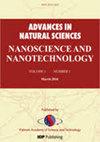GaN:Ag 和 SiC:Ag 纳米管的铁磁性预测
IF 2.1
Q3 MATERIALS SCIENCE, MULTIDISCIPLINARY
Advances in Natural Sciences: Nanoscience and Nanotechnology
Pub Date : 2024-08-28
DOI:10.1088/2043-6262/ad71a7
引用次数: 0
摘要
基于假势法进行的ab initio模拟研究了单壁(6,0)GaN(SiC):Ag纳米管中的铁磁性。对于 GaN:Ag 单壁纳米系统,带隙宽度随着掺杂浓度的增加而减小。而掺杂了银的碳化硅纳米管,多数自旋态的带隙减小,这些体系显示出金属特性。SiC(GaN):Ag 纳米管总能量的第一原理结果分别预测了铁磁相和反铁磁相的稳定性。Ag-GaN 和 Ag-SiC 系统的总磁矩值分别为 ∼2.0 和 ∼3.2 μB。对状态密度结果的分析表明,缺陷 GaN:Ag 和 SiC:Ag 系统的磁化主要来自与掺杂剂成键的三个氮原子和碳原子。第一原理研究表明,SiC(GaN):Ag 纳米管可以制成磁性材料,是电子、光电和自旋电子器件的理想候选材料。本文章由计算机程序翻译,如有差异,请以英文原文为准。
Prediction of ferromagnetism in GaN:Ag and SiC:Ag nanotubes
Ferromagnetism in single-walled (6,0) GaN(SiC):Ag nanotubes were studied based on ab initio simulations within a pseudopotential method. For the GaN:Ag single-walled nanosystems, the width of the band gap reduces with the increase of dopant concentration. While Ag-doped SiC nanotubes, the band gap of majority-spin states decrease and these systems show metallic character. The first-principles results of total energies for SiC(GaN):Ag nanotubes predicted the stability of the ferromagnetic and antiferromagnetic phase, respectively. The obtained values of total magnetic moments of Ag-GaN and Ag-SiC systems are ∼2.0 and ∼3.2 μB, respectively. The analysis of the results of density of states show the significant contribution to the magnetization of both defected GaN:Ag and SiC:Ag systems come from three nitrogen and carbon atoms which are bonded with the dopant. First-principles investigation, suggest that the SiC(GaN):Ag nanotubes can be made into magnetic materials, and these are promising candidates for electronic, optoelectronic, and spintronic devices.
求助全文
通过发布文献求助,成功后即可免费获取论文全文。
去求助
来源期刊

Advances in Natural Sciences: Nanoscience and Nanotechnology
NANOSCIENCE & NANOTECHNOLOGYMATERIALS SCIE-MATERIALS SCIENCE, MULTIDISCIPLINARY
自引率
4.80%
发文量
0
 求助内容:
求助内容: 应助结果提醒方式:
应助结果提醒方式:


